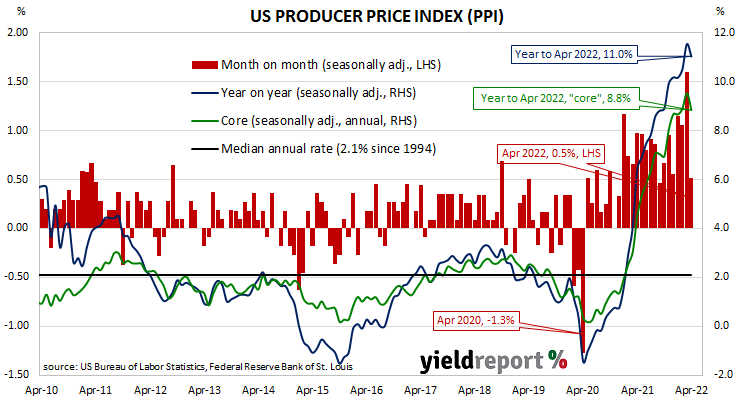Summary: US producer price index (PPI) up 0.5% in April, in line with expectations; annual rate falls from 11.5% to 11.0%; “core” PPI up 0.4%; producer price pressures remain elevated, likely to continue filtering through to consumer prices”; US Treasury yields lower, rate-rise expectations ease.
Around the end of 2018, the annual inflation rate of the US producer price index (PPI) began a downtrend which continued through 2019. Months in which producer prices increased suggested the trend may have been coming to an end, only for it to continue, culminating in a plunge in April 2020. Figures returned to “normal” towards the end of that year but annual rates over the past twelve months have been well above the long-term average.
The latest figures published by the Bureau of Labor Statistics indicate producer prices rose by 0.5% after seasonal adjustments in April. The increase was in line with consensus expectations but considerably less than March’s revised figure of 1.6%. On a 12-month basis, the rate of producer price inflation after seasonal adjustments slowed from March’s revised rate of 11.5% to 11.0%.
Producer prices excluding foods and energy, or “core” PPI, rose by 0.4% after seasonal adjustments. The increase was considerably lower than the 0.7% rise which had been generally expected as well as March’s revised figure of 1.2%. The annual rate decreased from March’s revised rate of 9.5% to 8.8%.
“While the core measures may show some moderation in price pressures, the data shows that producer price pressures remain elevated and this is likely to continue to filter through into consumer prices,” said NAB Head of Markets Strategy Skye Masters.
US Treasury bond yields fell moderately on the day. By the close of business, 2-year and 10-year Treasury yields had both shed 4bps to 2.58% and 2.89% respectively while the 30-year yield finished 3bps lower at 3.02%.
In terms of US Fed policy, expectations of higher federal funds rates over the next 12 months softened. At the close of business, June contracts implied an effective federal funds rate of 1.095%, 26bps higher than the current spot rate. July contracts implied 1.415% while May 2023 futures contracts implied an effective federal funds rate of 2.935%, 210bps above the spot rate.
The producer price index is a measure of prices received by producers for domestically produced goods, services and construction. It is put together in a fashion similar to the consumer price index (CPI) except it measures prices received from the producer’s perspective rather than from the perspective of a retailer or a consumer. It is another one of the various measures of inflation tracked by the US Fed, along with core personal consumption expenditure (PCE) price data.


